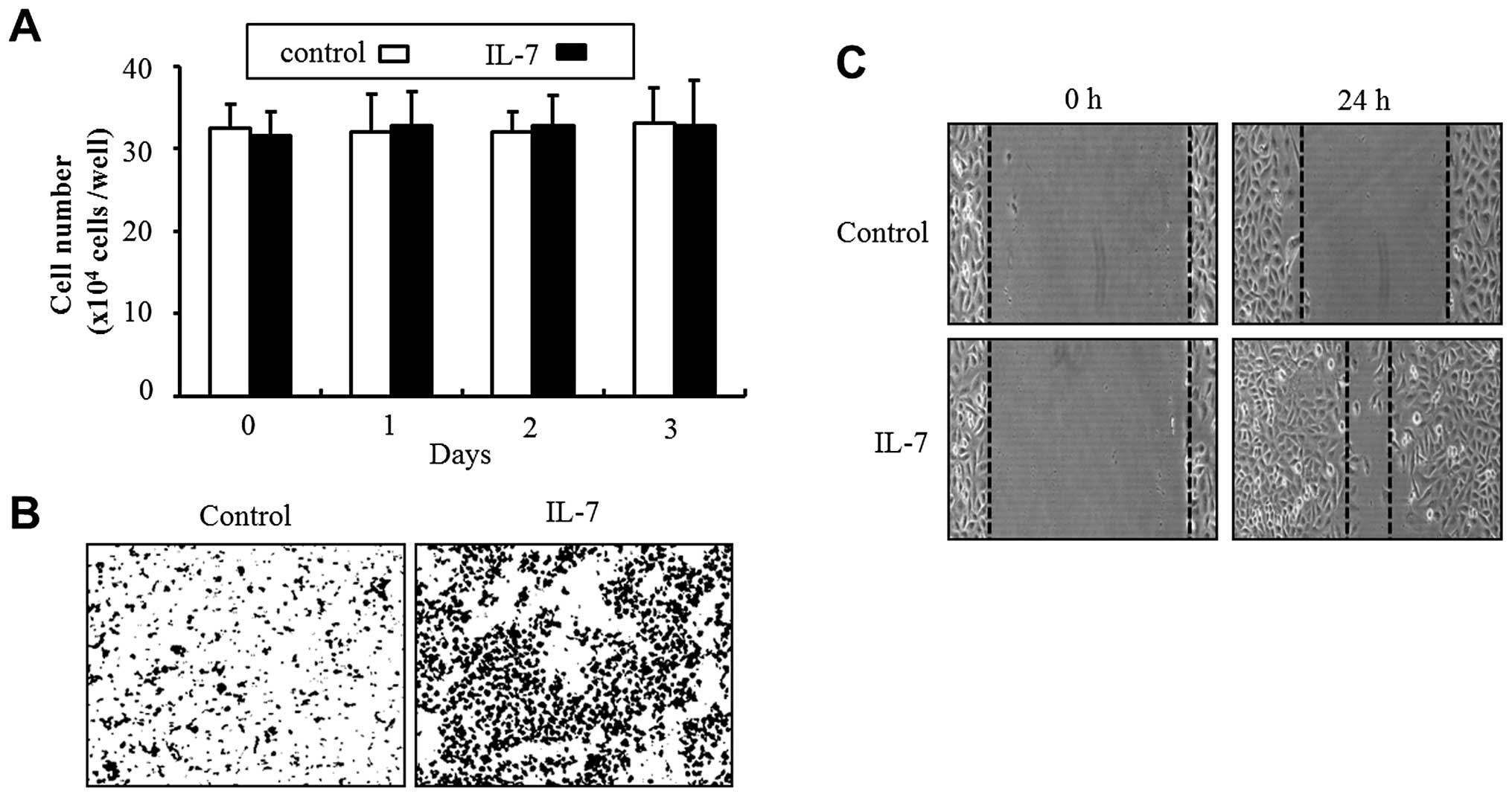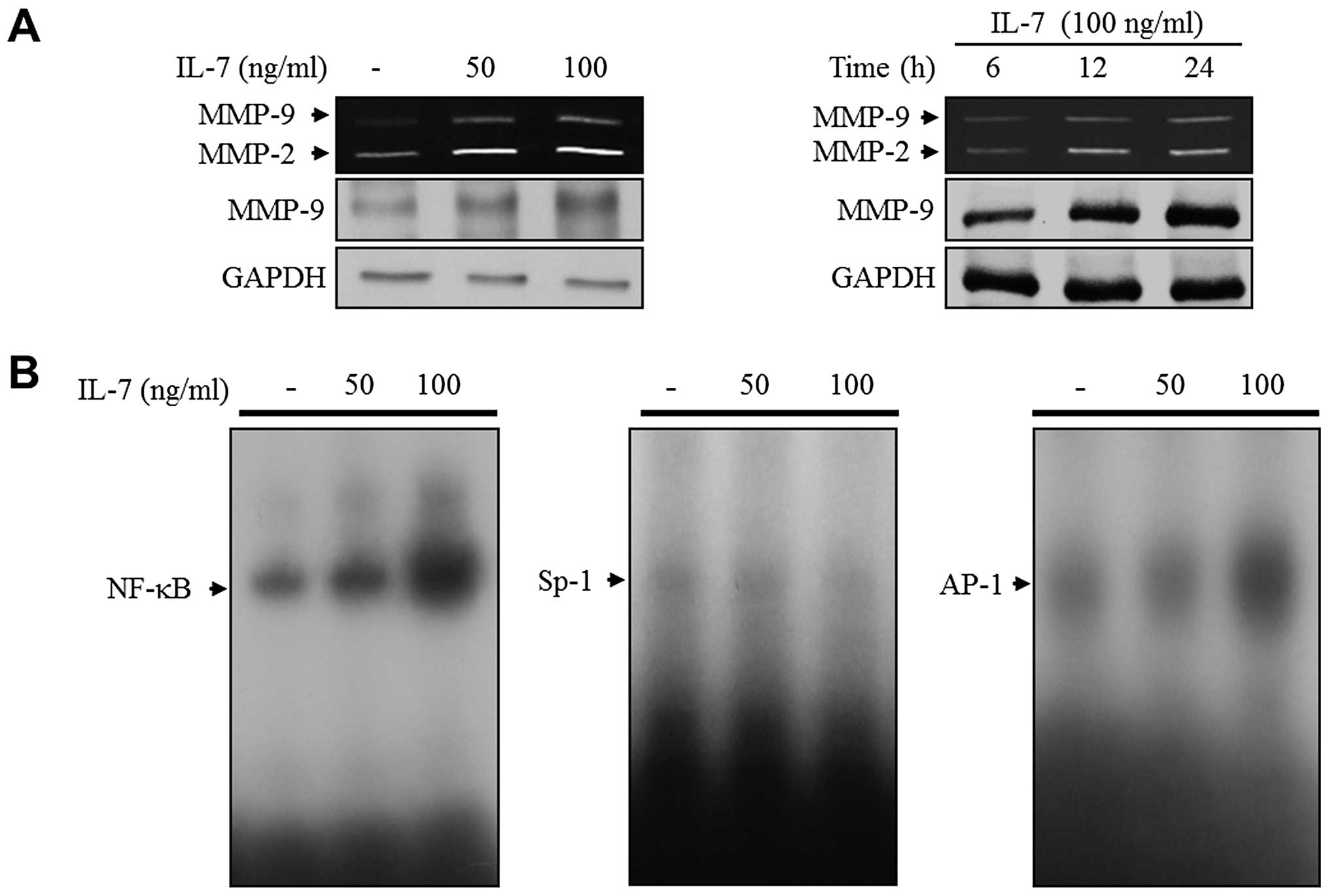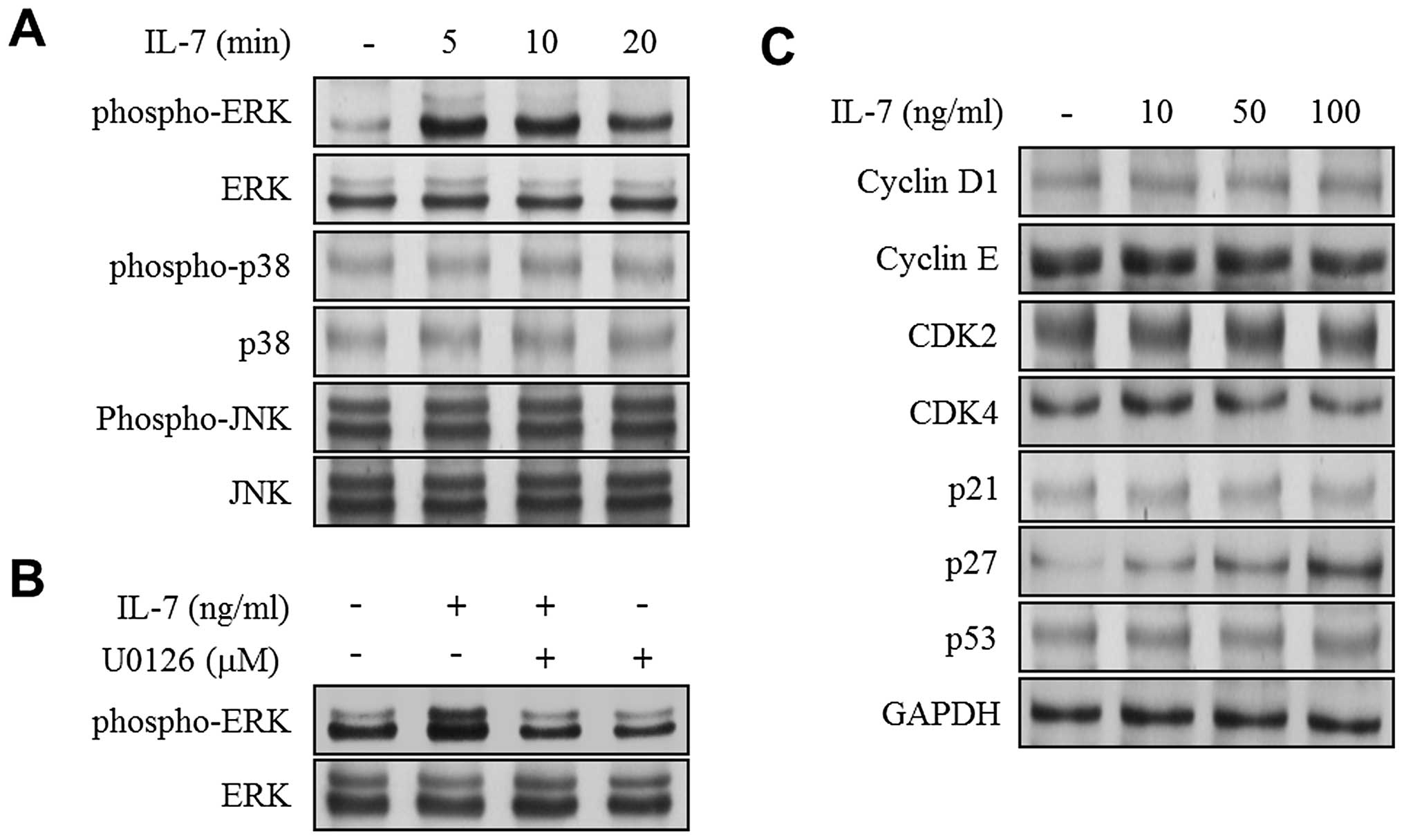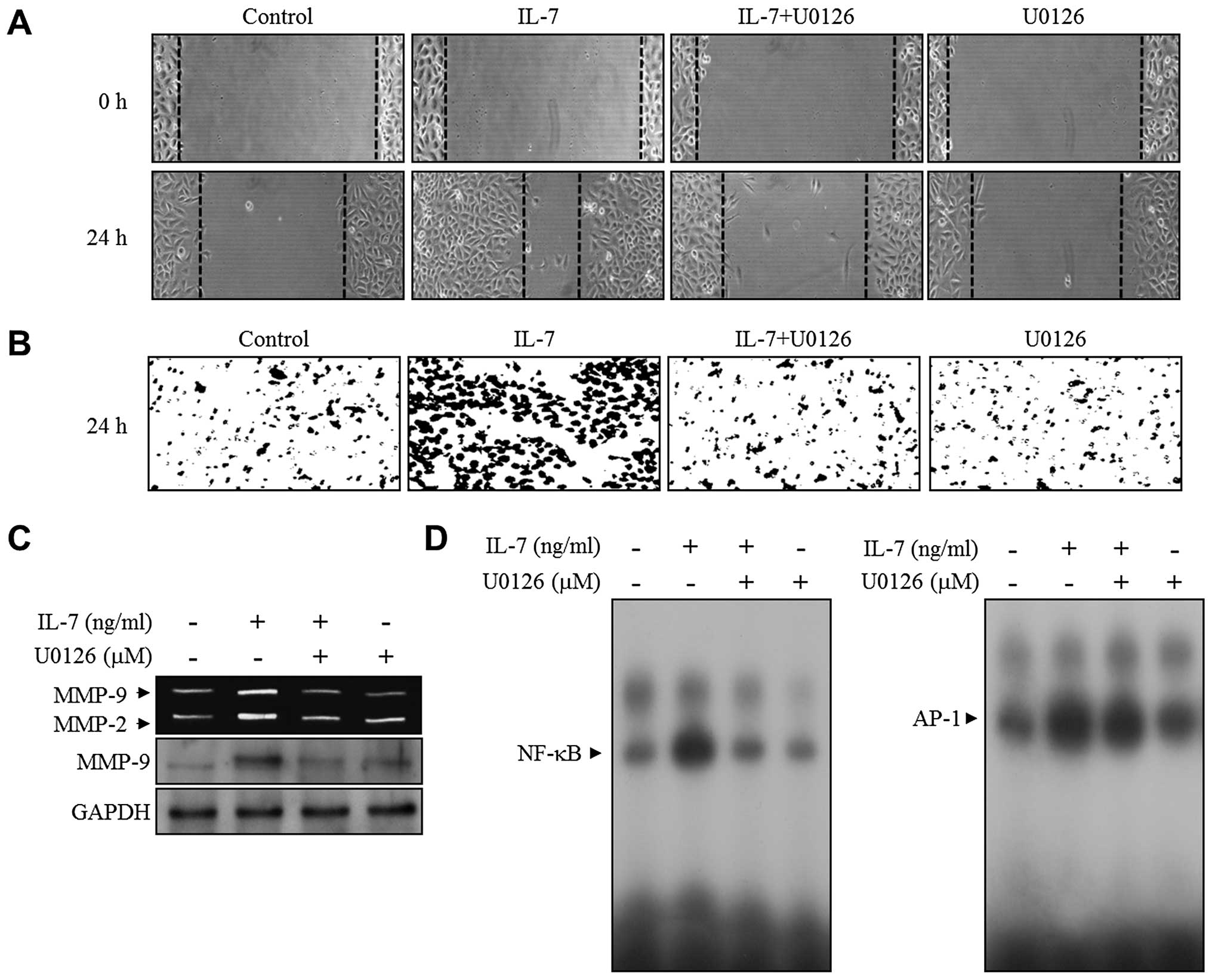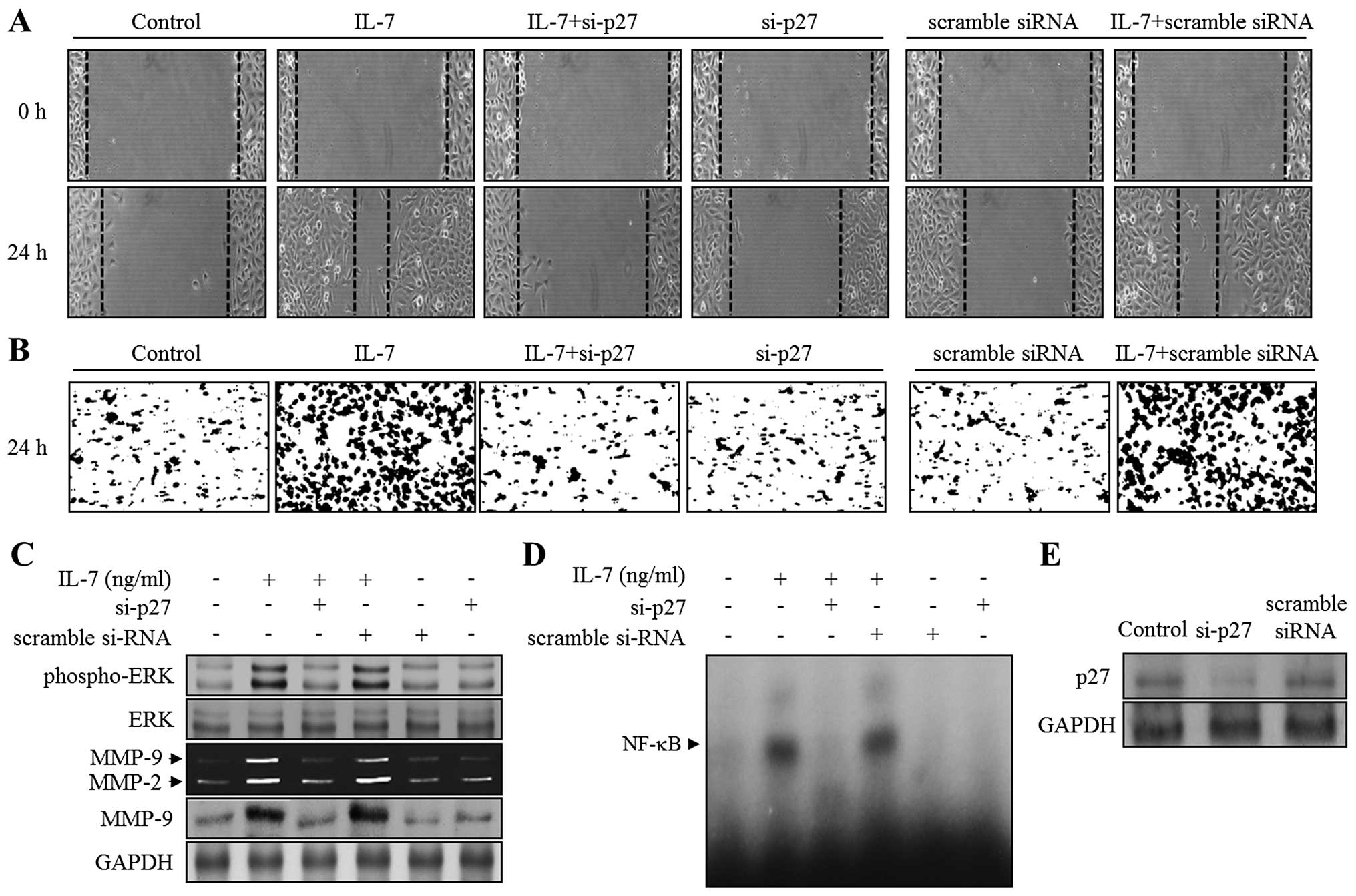p27KIP1 is involved in ERK1/2-mediated MMP-9 expression via the activation of NF-κB binding in the IL-7-induced migration and invasion of 5637 cells
- Authors:
- Published online on: February 4, 2014 https://doi.org/10.3892/ijo.2014.2290
- Pages: 1349-1356
Abstract
Introduction
Bladder cancer is one of the most lethal diseases in developed countries. The major type of bladder cancer leading to death is transitional cell carcinoma (TCC), which is characterized by muscle invasive bladder cancer (MIBC) (1,2). Most of the MIBC found in TCC is deeply involved in metastasis, migration and invasion (3). An understanding of the molecular mechanisms involved in the migration and invasion of MIBC could lead to identification of therapeutic targets for effective treatment.
Members of the matrix metalloproteinase (MMP) family are capable of degrading the extracellular matrix, and have been associated with essential roles in the migration and invasion of tumor cells (3–5). This has been correlated with gelatinase activity by MMP-2 (72 kDa) and MMP-9 (92 kDa) (4,5). Several studies have examined the MMP-9 association with the progression of bladder cancer that involves tumor grade, invasion, migration and metastasis (3). In addition, the expression of MMP-9 is strongly increased through the release of several cytokines and growth factors in different types of cells (6–9). Transcription factors including NF-κB, Sp-1 and AP-1 have been identified as essential mediators for the induction of MMP-9 in cancer cells (6–10). Cumulative studies have demonstrated that signaling pathways such as MAPK and AKT contribute to the MMP-9 expression that is regulated by transcription factors (8,9,11–13).
Interleukin-7 (IL-7) is an essential survival factor of T and B cells (14,15). It has been demonstrated that IL-7 exerts proliferative activity on murine B-cells within the bone marrow culturing system (14,15), and studies have suggested regulatory roles for IL-7 that involve in the proliferation, differentiation, and survival in the development of lymphocytes (14,15). Recent studies have shown the effect of IL-7 in anti-apoptotic function and in cell cycle progression during T-cell proliferation (14,15). The binding of IL-7 to the IL-7 receptor α chain (IL-7Rα) stimulated the activation of Jak/Stat and PI3K/AKT signaling in T-cells (14,15). Although many studies have demonstrated the biological function of IL-7 in the context of T- and B-cell homeostasis, its exact regulatory mechanism in the migration and invasion of tumor cells has yet to be fully explained.
Herein we demonstrate the novel molecular mechanisms underlying the migration and invasion of bladder cancer cells induced by cytokine IL-7. The present study is the first to focus on the function of IL-7 as it applies to the migration and invasion of tumor cells. Our results demonstrated that p27KIP1 is required for the IL-7-induced migration and invasion of bladder cancer 5637 cells via ERK1/2-mediated MMP-9 expression and the activation of the NF-κB binding motif.
Materials and methods
Materials
Polyclonal antibodies to ERK, phospho-ERK, p38MAPK, phospho-p38MAPK, JNK, and phospho-JNK were obtained from Cell Signaling (Danvers, MA, USA). Polyclonal antibodies to cyclin E, CDK2, CDK4, cyclin D1, p53, p21WAF1, p27KIP1 and GAPDH were obtained from Santa Cruz (Santa Cruz, CA, USA). U0126 was obtained from Calbiochem (San Diego, CA, USA). The polyclonal MMP-9 antibody was obtained from Chemicon. Small interfering RNA (siRNA) oligonucleotides targeting p27KIP1 (5′-CAA ACGUGCGAGUGUCUAAUU-3′) and scramble (5′-CUGUCA GUCAGUCGUAGUAUU-3′) were designed and synthesized by Genolution (Seoul, Korea).
Cell cultures
A human bladder carcinoma cell line (5637) was obtained from the American Type Culture Collection. The cells were maintained in DMEM (4.5 g glucose/liter) supplemented with 10% fetal calf serum, L-glutamine, and antibiotics (Biological Industries, Beit Haemek, Israel) at 37°C in a 5% CO2 humidified incubator.
Cell proliferation
Cells were placed in 12-well culture plates at 4×104 cells/ml with DMEM containing 10% FBS. Cells were incubated at 37°C for 24 h. The medium was then exchanged for serum-free medium. After 24 h, the cells were stimulated with IL-7 and then trypsinized with trypsin-EDTA. Cells were counted using a coulter counter chamber (Coulter Corp., FL, USA).
Immunoblot analysis
Growth-arrested cells were treated with IL-7 in the absence of 10% FBS for various durations at 37°C. The cells were then washed twice with cold PBS and freeze-thawed in 250 μl lysis buffer [containing, in mmol/l, HEPES (pH 7.5) 50, NaCl 150, EDTA 1, EGTA 2.5, DTT 1, β-glycerophosphate 10, NaF 1, Na3VO4 0.1, and phenylmethylsulfonyl fluoride 0.1 and 10% glycerol, 0.1% Tween-20, 10 μg/ml of leupeptin, and 2 μg/ml of aprotinin], and then scraped into 1.5 ml tubes. The lysates were placed on ice for 15 min and then centrifuged at 12,000 rpm for 20 min at 4°C. The protein concentration of the supernatant was determined using a Bradford reagent method (Bio-Rad). Equal amounts of cellular proteins were resolved by electrophoresis on a 0.1% SDS-10% polyacrylamide gel (SDS-PAGE) under denaturing conditions. The proteins were transferred electrophoretically to nitrocellulose membranes (Hybond, Amersham Corp.). After blocking in 10 mmol/l Tris-HCl (pH 8.0), 150 mmol/l NaCl, and 5% (wt/vol) non-fat dry milk, the membranes were treated with primary antibodies for 90 min, followed by incubation with peroxidase-conjugated secondary antibodies for 45 min. The immunocomplexes were detected using a chemiluminescence reagent kit (Amersham Corp.). For the immunoblotting studies, the experiments were repeated at least 3 times.
Wound-healing migration assay
Cells were plated on 6-well dishes and grown to 90% confluence in 2 ml of growth medium. A wound was created in cells using a 2-mm-wide tip and then the cells were treated with IL-7. They were allowed to migrate, and photographs were taken through an inverted microscope (×40 magnification).
Invasion assay
Cells (2.5×104) were resuspended with IL-7 in 100 μl of medium and placed in the upper part of a transwell plate. The cells were then incubated for 24 h. The cells had to pass through a polycarbonate membrane with 8 μm-sized pores and a thin layer of an ECM Matrix-like material. The ability of the cells to invade the ECM Matrix-like material was determined using a commercial cell invasion assay kit (Chemicon International, Billerica, MA, USA).
Zymography
Conditioned medium was electrophoresed in a polyacrylamide gel containing 1 mg/ml gelatin. The gel was then washed at room temperature for 2 h with 2.5% Triton X-100 and subsequently at 37°C overnight in a buffer containing 10 mM CaCl2, 150 mM NaCl and 50 mM Tris-HCl, pH 7.5. The gel was stained with 0.2% Coomassie blue and photographed using a light box. Proteolysis was detected as a white zone in a dark blue field (8,9).
Transfection
Cells were transfected with siRNA using Lipofectamine 2000 transfection reagent according to the manufacturer’s protocols (Invitrogen). After the indicated incubation with IL-7, the cells were studied via immunoblot, zymography, EMSA, invasion and wound healing migration.
Nuclear extracts and electrophoretic mobility shift assay (EMSA)
Cultured cells were collected by centrifugation, washed and suspended in a buffer containing 10 mM HEPES (pH 7.9), 10 mM KCl, 0.1 mM EDTA, 0.1 mM EGTA, 1 mM DTT and 0.5 mM PMSF. After 15 min on ice, the cells were vortexed in the presence of 0.5% Nonidet NP-40. The nuclear pellet was then collected by centrifugation and extracted in a buffer containing 20 mM HEPES pH 7.9, 0.4 M NaCl, 1 mM EDTA, 1 mM EGTA, 1 mM DTT, and 1 mM PMSF for 15 min at 4°C.
The nuclear extract (10–20 μg) was preincubated at 4°C for 30 min with the 100-fold excess of an unlabeled oligonucleotide spanning the -79 MMP-9 cis-element of interest. The sequences were as follows: AP-1, CTGACCCCTGAGTCAGCACTT; NF-κB, CAGTGGAATTCCCCAGCC; and, Sp-1, GCCCATTCCTTCCGCCCCCAGATGAAGCAG. The reaction mixture was then incubated at 4°C for 20 min in a buffer (25 mM HEPES buffer pH 7.9, 0.5 mM EDTA, 0.5 mM DTT, 0.05 M NaCl, and 2.5% glycerol) with 2 μg of poly dI/dC and 5 fmol (2×104 cpm) of a Klenow end-labeled (32P-ATP) 30-mer oligonucleotide, which spanned the DNA binding site in the MMP-9 promoter. The reaction mixture was electro-phoresed at 4°C in a 6% polyacrylamide gel using a TBE (89 mM Tris, 89 mM boric acid and 1 mM EDTA) running buffer. The gel was rinsed with water, dried and exposed to X-ray film overnight (8,9).
Statistical analysis
Where appropriate, data were expressed as the mean ± SE. Data were analyzed by factorial ANOVA and a Fisher’s least significant difference test where appropriate. Statistical significance was set at P<0.05.
Results
IL-7 induces wound-healing migration and invasion of bladder cancer 5637 cells
To investigate whether IL-7 would induce the migration and invasion of bladder cancer 5637 cells, a wound-healing migration and Matrigel invasion assay was performed. A treatment of 5637 cells with IL-7 for 24 h significantly increased migration into the wound area, compared with the control cells (Fig. 1C). In addition, the results from the invasion assay showed that IL-7 treatment produced strong invasiveness through Matrigel by comparison with non-treated cells (Fig. 1B). However, exposure to IL-7 had no effect on cell proliferation (Fig. 1A).
IL-7 promotes MMP-9 expression via binding activation of the NF-κB and AP-1 motifs
To define the involvement of MMP expression in the IL-7-induced migration and invasion of 5637 cells, we examined MMP expression using a zymographic assay. IL-7 was used to treat with 5637 cells at the indicated concentrations in the serum-starved medium for 24 h. IL-7 treatment showed a dose-dependent increase in the expressions of both MMP-2 and MMP-9 (Fig. 2A). In addition, the level of both MMP-2 and MMP-9 expression was increased in IL-7-treated cells in a time-dependent manner (Fig. 2A). Similar results were observed in immunoblot analysis (Fig. 2A). Previous studies have implicated the expression of MMP-9 in the migration and invasion of bladder cancer cells (3). Therefore, we next focused on the MMP-9 expression in IL-7-treated 5637 cells. To define the regulatory mechanism of MMP-9 expression, an EMSA experiment was conducted. The 5637 cells were treated with IL-7 at indicated concentrations for 24 h, and the binding activity of the transcription factors was investigated using nuclear extracts, which are a part of several DNA binding elements of bladder cancer cells. As shown in Fig. 2B, IL-7 treatment significantly induced the binding activity of NF-κB and AP-1 motifs in 5637 cells. However, there was no binding activity of Sp-1 in IL-7-treated 5637 cells (Fig. 2B). These results indicate that IL-7 may induce MMP-9 expression by activating the binding function of transcription factor NF-κB and that of AP-1 in bladder cancer 5637 cells.
IL-7 stimulates the phosphorylation of ERK1/2 and increases the expression of p27KIP1 in 5637 cells
To determine the signaling pathways underlying molecular events in the bladder cancer cells that are induced by IL-7, we examined the MAPK signaling molecules ERK1/2, JNK and p38MAPK. In the present study, IL-7 induced the maximum level of ERK1/2 phosphorylation within 5 min (Fig. 3A). This effect was inhibited by adding the ERK1/2 inhibitor U0126 (Fig. 3B). However, IL-7 did not induce the phosphorylation of either JNK or p38MAPK in 5637 cells (Fig. 3A). IL-7 is known to modulate cell cycle progression in lymphocytes (14,15). Therefore, the expression levels of cell cycle proteins were examined in bladder cancer cells in response to IL-7. The 5637 cells were treated with IL-7 for 24 h, and the levels of cell cycle regulatory proteins were determined using immunoblot analysis. The results of the present study demonstrated that the expression level of p27KIP1 was induced by IL-7 treatment dose-dependently (Fig. 3C). However, no significant increase was observed for the expression levels of other proteins (cyclin D1, cyclin E, CDK2, CDK4, p21WAF1, and p53) in IL-7-treated 5637 cells (Fig. 3C).
ERK1/2 signaling is involved in NF-κB-mediated MMP-9 expression during the migration and invasion of bladder cancer 5637 cells induced by IL-7
To determine the potential role of ERK1/2 signaling, the effect of ERK1/2 inhibitor U0126 was investigated in the IL-7-induced migration and invasion of bladder cancer cells. The 5637 cells were pre-treated with U0126 followed by IL-7 treatment. Inhibition of ERK1/2 signaling blocked the wound-healing migration and invasion of the 5637 cells induced by IL-7 (Fig. 4A and B). A subsequent study was designed to elucidate the ERK1/2 signaling, which induces the expression of the MMP-9 in IL-7-treated bladder cancer 5637 cells. The effect of U0126 on MMP-9 expression was analyzed. Zymographic and immunoblot analysis showed that IL-7-induced MMP-9 expression was suppressed by the addition of U0126 (Fig. 4C). To further define the functional role of ERK1/2 signaling in the transcriptional regulation associated with the upregulation of MMP-9 expression in IL-7-treated bladder cancer 5637 cells, an EMSA assay was performed in both the presence and absence of U0126 using NF-κB and AP-1 binding motifs. The induction of NF-κB binding activation by IL-7 was attenuated in the presence of U0126 to the control level, whereas U0126 had no effect on the binding activation of AP-1 in IL-7-stimulated 5637 cells (Fig. 4D). These results showed that ERK1/2 signaling is associated with MMP-9 expression via the NF-κB binding activity in IL-7-stimulated bladder cancer cells.
siRNA-mediated knockdown of p27KIP1 restores migration, invasion, MMP-9 expression, ERK1/2 activation, and binding activity of NF-κB in IL-7-stimulated bladder cancer cells
Our results showed that IL-7 induces p27KIP1 expression (Fig. 3C). Moreover, IL-7 promoted cellular responses, such as ERK1/2 phosphorylation, MMP-9 expression, NF-κB binding activity, migration, and invasion, in bladder cancer cells. Thus, the results reported above prompted us to examine whether p27KIP1 is involved in IL-7-mediated bladder cancer cellular responses. To confirm this hypothesis, either a p27KIP1-specific siRNA (si-p27) or a scrambled siRNA was transfected into bladder cancer cells, which were then stimulated with IL-7. The knockdown of p27KIP1 was characterized by immunoblot analysis (Fig. 5E). IL-7 treatment of 5637 cells, and of cells transfected with scrambled siRNA, promoted both wound healing and invasion (Fig. 5A and B). This enhancement was almost abolished in si-p27 transfected cells (Fig. 5A and B). IL-7-induced phosphorylation of ERK1/2 was recovered in cells transfected with si-p27 (Fig. 5C). In addition, zymography and immunoblot analysis showed that IL-7 treatment of 5637 cells transfected with si-p27 resulted in the reduction of MMP-9 expression (Fig. 5C). Finally, as shown in Fig. 5D, NF-κB DNA binding activity induced by IL-7 was almost completely suppressed by the transfection of si-p27. These results suggest that p27KIP1 might contribute to the migration and invasion of bladder cancer cells through ERK1/2-associated MMP-9 expression by activating the NF-κB binding ability in IL-7-stimulated bladder cancer cells.
Discussion
Several studies have demonstrated the essential role of cytokine IL-7 in the development and survival of lymphocytes (14,15). Many studies have suggested that IL-7 is an immune responsive cytokine responsible for the proliferation of T-cells and the growth of murine B-cell precursors (14,15). At least two studies have suggested a vital role for IL-7 in the induction of anti-apoptotic factors and the regulation of cell cycle progression in lymphocytes (14,15). However, to date, the molecular events underlying the migration and invasion of tumor cells that is induced by IL-7 remain unclear. In the present study, we demonstrated the roles and molecular mechanisms that integrate migration, invasion, MMP-9 regulation, signaling pathway, and cell-cycle regulation in IL-7-stimulated bladder cancer cells.
The progression of tumors has long been associated with the migration and invasion of cancer cells, which is an essential step in degradation of the extracellular matrix (ECM) by proteolytic enzymes including MMP-2 and MMP-9 (4,5). Based on these reports, we postulated that IL-7 might have a pivotal role in the development and progression of tumor cells. Initially, we examined the ability of bladder cancer 5637 cells to migrate and invade when treated with IL-7. The result from the present study showed that IL-7 promoted the induction of wound-healing migration. Consistent with this result, invasive capacity through Matrigel was also enhanced by IL-7 treatment. In addition, the treatment of bladder cancer 5637 cells with IL-7 induced the expression of MMP-2 and MMP-9. Cumulative studies have suggested that MMP-9 expression is an important element in tumor grade, invasion, migration, and metastasis in bladder cancer (3). In in vivo orthotopic xenograft models, the role of MMP-9 has been documented in bladder tumors (3,16). Previous reports have used validation studies associated with tumor grade and metastasis to document preclinical evidence that shows a key role for MMP-9 in bladder cancer (17–21). Therefore, we next focused on the identification of the transcription factors regulating MMP-9 in IL-7-stimulated bladder cancer cells. Several transcription factors that regulate MMP-9 promoters have been identified in tumor cells: NF-κB, Sp-1, and AP-1 (6–10). The results from our EMSA data identified NF-κB and AP-1 as main regulatory factors of IL-7-mediated MMP-9 expression in 5637 bladder cancer cells. These results are the first to show that IL-7 induces MMP-9 expression through the activation of transcription factors NF-κB and AP-1 in bladder cancer cells, which results in the breakdown of the ECM and contributes to migration and invasion.
A number of studies have identified signal transduction pathways that are correlated with the biological responses of lymphocytes in response to IL-7 (14,15). Previous studies have shown that cytokine IL-7 induces the phosphorylation of Jak2/Stat3, PI3/AKT, and Src in T-cells and B-cells (14,15). In addition, the binding of IL-7 to IL-7Rα triggers the phosphorylation of MAPKs, such as ERK1/2 and p38MAPK, in T-cells and B-cells (22,23). Consistent with earlier studies, the present results show the phosphorylation of ERK1/2 in IL-7-treated bladder cancer 5637 cells. Previously, the involvement of ERK1/2 signaling has been suggested in the regulation of the migration and expression of MMP-9 in different types of cells (8,9,12,13,24). However, the role of the signaling pathway in IL-7-mediated cell migration and invasion remains unclear. In the present study, we showed that ERK1/2 kinase inhibitor U0126 inhibited both wound-healing migration and Matrigel invasion in IL-7-stimulated 5637 bladder cancer cells. In addition, the inhibition of ERK1/2 by pre-incubation with U0126 suppressed the MMP-9 expression and NF-κB binding activity induced by IL-7 in 5637 cells without alteration of the AP-1 binding activity. The results of the present study clearly suggest that ERK1/2 signaling is an essential factor in the transcription factor NF-κB-mediated MMP-9 expression in IL-7-stimulated migration and invasion of bladder cancer cells.
In addition to its role in modulating the development, survival, and proliferation of lymphocytes (14,15), several studies have suggested that IL-7 plays a role in the cell cycle regulation of T-cells (14,15). IL-7 is known to promote cell proliferation through the decreased level of p27KIP1 and increased activation of CDK2 and CDK4 in T-cells (25,26). A previous study has shown that the p27KIP1 expression is intensely associated with IL-7Rα in the T cell lineage (27). However, the effect of IL-7 on cancer cell response has not been previously reported. In the present study, we examined the expression level of p27KIP1 in the presence of IL-7, and found an increase in treated bladder cancer cells. In an attempt to understand the involvement of p27KIP1 in the IL-7-induced migration and invasion of bladder cancer cells, we conducted a p27KIP1-specific siRNA knockdown experiment. The results from the present study demonstrated that p27KIP1 is a crucial factor for the migration and invasion of bladder cancer cells induced by IL-7. Our data also showed that p27KIP1 regulated the ERK1/2-mediated expression of MMP-9 via the binding activation of the NF-κB motif in the migration and invasion of bladder cancer cells induced by IL-7. These studies suggest that p27KIP1 may be involved in the cascade of migration and invasion of cancer cells, which leads to bladder cancer progression.
Many studies have shown that inflammatory cytokines have a dual role that includes the induction of tumor progression as well as an inhibitory effect of tumor growth (28–30). The results of the present study showed a novel role for IL-7, as it proved to be responsible for the migration and invasion of bladder cancer cells without altering the cell growth. A previous study showed that the decreased expression of p27KIP1 resulted in a disease progression in patients with colorectal and breast cancer (31,32). In addition, p27KIP1 status has been associated with recurrence and disease-specific mortality in patients with bladder tumors (33). However, the exact mechanism of the cell cycle regulators underlying the migration and invasion in IL-7-treated cancer cells remains to be elucidated. The results from the present study revealed that p27KIP1 is an essential factor in the migration and invasion of bladder cancer cells induced by IL-7.
In conclusion, the present study presents novel evidence demonstrating that p27KIP1 is associated with ERK1/2-mediated MMP-9 expression via the binding activity of the NF-κB motif in IL-7-stimulated bladder cancer cells, which subsequently leads to migration and invasion. These results form a theoretical basis for the progression of bladder cancer, and future study is required to examine the efficacy of the IL-7 gene using animal models.
Acknowledgements
This study was supported by the Basic Science Research Program through the National Research Foundation of Korea (NRF), funded by the Ministry of Education, Science and Technology (2008-0062611).
References
|
Jemal A, Siegel R, Ward E, Murray T, Xu J and Thun MJ: Cancer statistics, 2007. CA Cancer J Clin. 57:43–66. 2007. View Article : Google Scholar | |
|
Levi F, La Vecchia C, Randimbison L and Franceschi S: Incidence of infiltrating cancer following superficial bladder carcinoma. Int J Cancer. 55:419–554. 1993. View Article : Google Scholar : PubMed/NCBI | |
|
Black PC and Dinney CP: Bladder cancer angiogenesis and metastasis - translation from murine model to clinical trial. Cancer Metastasis Rev. 26:623–634. 2007. View Article : Google Scholar : PubMed/NCBI | |
|
Matrisian LM: Metalloproteinases and their inhibitors in matrix remodeling. Trends Genet. 6:121–125. 1990. View Article : Google Scholar : PubMed/NCBI | |
|
Liotta LA: Tumor invasion and metastasis-role of extracellular matrix: Rhoads Memorial Award Lecture. Cancer Res. 46:1–7. 1986.PubMed/NCBI | |
|
Bond M, Rosalind P, Fabunmi P, Baker AH and Newby AC: Synergistic upregulation of metalloproteinase-9 by growth factors and inflammatory cytokines: an absolute requirement for transcription factor NF-kappa B. FEBS Lett. 435:29–34. 1998. View Article : Google Scholar : PubMed/NCBI | |
|
Sato H and Seiki M: Regulatory mechanism of 92 kDa type IV collagenase gene expression which is associated with invasiveness of tumor cells. Oncogene. 8:395–405. 1993.PubMed/NCBI | |
|
Lee SJ, Cho SC, Lee EJ, Kim S, Lee SB, Lim JH, Choi YH, Kim WJ and Moon SK: Interleukin-20 promotes migration of bladder cancer cells through extracellular signal-regulated kinase (ERK)-mediated MMP-9 protein expression leading to nuclear factor (NF-κB) activation by inducing the up-regulation of p21(WAF1) protein expression. J Biol Chem. 288:5539–5552. 2013.PubMed/NCBI | |
|
Moon SK, Cha BY and Kim CH: ERK1/2 mediates TNF-alpha-induced matrix metalloproteinase-9 expression in human vascular smooth muscle cells via the regulation of NF-kappaB and AP-1: involvement of the ras dependent pathway. J Cell Physiol. 198:417–427. 2004. View Article : Google Scholar : PubMed/NCBI | |
|
Sato H, Kita M and Seiki M: v-Src activates the expression of 92-kDa type IV collagenase gene through the AP-1 site and the GT box homologous to retinoblastoma control elements. A mechanism regulating gene expression independent of that by inflammatory cytokines. J Biol Chem. 268:23460–23468. 1993.PubMed/NCBI | |
|
Nicosia SV, Bai W, Cheng JQ, Coppola D and Kruk PA: Oncogenic pathways implicated in ovarian epithelial cancer. Hematol Oncol Clin North Am. 17:927–943. 2003. View Article : Google Scholar : PubMed/NCBI | |
|
Cho A, Graves J and Reidy MA: Mitogen-activated protein kinases mediate matrix metalloproteinase-9 expression in vascular smooth muscle cells. Arterioscler Thromb Vasc Biol. 20:2527–2532. 2000. View Article : Google Scholar : PubMed/NCBI | |
|
Yao J, Xiong S, Klos K, Nguyen N, Grijalva R, Li P and Yu D: Multiple signaling pathways involved in activation of matrix metalloproteinase-9 (MMP-9) by heregulin-beta1 in human breast cancer cells. Oncogene. 20:8066–8074. 2001. View Article : Google Scholar : PubMed/NCBI | |
|
Kittipatarin C and Khaled AR: Interlinking interleukin-7. Cytokine. 39:75–83. 2007. View Article : Google Scholar | |
|
Jiang Q, Li WQ, Aiello FB, Mazzucchelli R, Asefa B, Khaled AR and Durum SK: Cell biology of IL-7, a key lymphotrophin. Cytokine Growth Factor Rev. 16:513–533. 2005. View Article : Google Scholar : PubMed/NCBI | |
|
Mian BM, Dinney CP, Bermejo CE, Sweeney P, Tellez C, Yang XD, Gudas JM, McConkey DJ and Bar-Eli M: Fully human anti-interleukin 8 antibody inhibits tumor growth in orthotopic bladder cancer xenografts via down-regulation of matrix metal-loproteases and nuclear factor-kappaB. Clin Cancer Res. 9:3167–3175. 2003.PubMed/NCBI | |
|
Sier CF, Casetta G, Verheijen JH, Tizzani A, Agape V, Kos J, Blasi F and Hanemaaijer R: Enhanced urinary gelatinase activities (matrix metalloproteinases 2 and 9) are associated with early-stage bladder carcinoma: a comparison with clinically used tumor markers. Clin Cancer Res. 6:2333–2340. 2000. | |
|
Davies B, Waxman J, Wasan H, Abel P, Williams G, Krausz T, Neal D, Thomas D, Hanby A and Balkwill F: Levels of matrix metalloproteases in bladder cancer correlate with tumor grade and invasion. Cancer Res. 53:5365–5369. 1993.PubMed/NCBI | |
|
Nutt JE, Durkan GC, Mellon JK and Lunec J: Matrix metalloproteinases (MMPs) in bladder cancer: the induction of MMP9 by epidermal growth factor and its detection in urine. BJU Int. 91:99–104. 2003. View Article : Google Scholar : PubMed/NCBI | |
|
Moses MA, Wiederschain D, Loughlin KR, Zurakowski D, Lamb CC and Freeman MR: Increased incidence of matrix metalloproteinases in urine of cancer patients. Cancer Res. 58:1395–1399. 1998.PubMed/NCBI | |
|
Di Carlo A, Terracciano D, Mariano A and Macchia V: Urinary gelatinase activities (matrix metalloproteinases 2 and 9) in human bladder tumors. Oncol Rep. 15:1321–1326. 2006.PubMed/NCBI | |
|
Fleming HE and Paige CJ: Pre-B cell receptor signaling mediates selective response to IL-7 at the pro-B to pre-B cell transition via an ERK/MAP kinase-dependent pathway. Immunity. 15:521–531. 2001. View Article : Google Scholar : PubMed/NCBI | |
|
Crawley JB, Rawlinson L, Lali FV, Page TH, Saklatvala J and Foxwell BM: T cell proliferation in response to interleukins 2 and 7 requires p38MAP kinase activation. J Biol Chem. 272:15023–15027. 1997. View Article : Google Scholar : PubMed/NCBI | |
|
Reddy KB, Nabha SM and Atanaskova N: Role of MAP kinase in tumor progression and invasion. Cancer Metastasis Rev. 22:395–403. 2003. View Article : Google Scholar : PubMed/NCBI | |
|
Li WQ, Jiang Q, Aleem E, Kaldis P, Khaled AR and Durum SK: IL-7 promotes T cell proliferation through destabilization of p27Kip1. J Exp Med. 203:573–582. 2006. View Article : Google Scholar : PubMed/NCBI | |
|
Barata JT, Cardoso AA, Nadler LM and Boussiotis VA: Interleukin-7 promotes survival and cell cycle progression of T-cell acute lymphoblastic leukemia cells by down-regulating the cyclin-dependent kinase inhibitor p27(kip1). Blood. 98:1524–1531. 2001. View Article : Google Scholar | |
|
Hofmeister R, Khaled AR, Benbernou N, Rajnavolgyi E, Muegge K and Durum SK: Interleukin-7: physiological roles and mechanisms of action. Cytokine Growth Factor Rev. 10:41–60. 1999. View Article : Google Scholar : PubMed/NCBI | |
|
Coussens LM and Werb Z: Inflammation and cancer. Nature. 420:860–867. 2002. View Article : Google Scholar : PubMed/NCBI | |
|
Dranoff G: Cytokines in cancer pathogenesis and cancer therapy. Nat Rev Cancer. 4:11–22. 2004. View Article : Google Scholar | |
|
Goswami B, Rajappa M, Sharma M and Sharma A: Inflammation: its role and interplay in the development of cancer, with special focus on gynecological malignancies. Int J Gynecol Cancer. 18:591–599. 2008. View Article : Google Scholar : PubMed/NCBI | |
|
Loda M, Cukor B, Tam SW, Lavin P, Fiorentino M, Draetta GF, Jessup JM and Pagano M: Increased proteasome-dependent degradation of the cyclin-dependent kinase inhibitor p27 in aggressive colorectal carcinomas. Nat Med. 3:231–234. 1997. View Article : Google Scholar | |
|
Catzavelos C, Bhattacharya N, Ung YC, Wilson JA, Roncari L, Sandhu C, Shaw P, Yeger H, Morava-Protzner I, Kapusta L, Franssen E, Pritchard KI and Slingerland JM: Decreased levels of the cell-cycle inhibitor p27Kip1 protein: prognostic implications in primary breast cancer. Nat Med. 3:227–230. 1997. View Article : Google Scholar : PubMed/NCBI | |
|
Shariat SF, Zlotta AR, Ashfaq R, Sagalowsky AI and Lotan Y: Cooperative effect of cell-cycle regulators expression on bladder cancer development and biologic aggressiveness. Mod Pathol. 20:445–459. 2007. View Article : Google Scholar : PubMed/NCBI |



